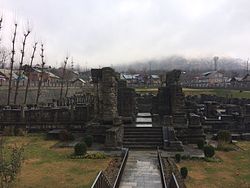Top Qs
Timeline
Chat
Perspective
Avantiswami Temple
Ancient temple ruins in Awantipora, India From Wikipedia, the free encyclopedia
Remove ads
The Avantiswami Temple is a ruined Hindu temple complex situated on the banks of the Jhelum River, approximately 16 km northeast of Pulwama town, in Awantipora, Pulwama district in Jammu and Kashmir, India. This site originally comprised two temples, one dedicated to Shiva and the other to Vishnu,[1] built during the reign of King Avantivarman of the Utpala dynasty in the 9th century CE. Today, the ruins are protected by the Archaeological Survey of India.[2][3] Locals call the temple Pandav Lari, meaning "house of the Pandavas".[4]
This article's tone or style may not reflect the encyclopedic tone used on Wikipedia. (March 2022) |
Remove ads
History
This section needs additional citations for verification. (March 2022) |
The temple was built by King Avantivarman between 853–855 CE. The site was located in the ancient town of Viswasara, which also served as the capital of Kashmir during his reign. Avantivarman, the founder of Avantipur and of the Utpala dynasty, is credited with building several Hindu temples across Kashmir, though many were later damaged or abandoned due to Muslim conquests.[5] During the Avantivarman's rule, the region experienced significant prosperity and cultural development. The Avantiswami Temple represents a fine example of Kashmiri stone temple architecture from that period.
Prior to the Muslim conquests, Kashmir was a center of Shaivism and Hindu philosophy, and a seat of Sanskrit learning and literature. By the 14th century, Kashmir had come under Muslim rule, and most of its early temples were deserted or sacked by the early 15th century. Two temples here are attributed to him: the Avantiswami Temple dedicated to Vishnu and the Avantishwara Temple dedicated to Shiva. The Avantiswami is smaller, but similar in planning to the earlier Martand Sun Temple.[6][7]
Remove ads
Architecture and Artwork
Surrounded by the remains of elaborately carved pillars, the Avantiswami Temple complex is situated on an elevated stone platform. Reliefs of mythological scenes that are still visible demonstrate the excellent craftsmanship of Kashmiri artisans in the ninth century. The temple's original design included a central shrine set inside a large oblong courtyard, four smaller shrines at the corners, and a roofed peristyle surrounded by monastic cells. The temple's ceremonial grandeur was enhanced by an imposing gateway that once marked its entrance.[8]
Remove ads
See also
References
Wikiwand - on
Seamless Wikipedia browsing. On steroids.
Remove ads






